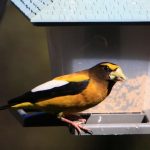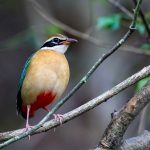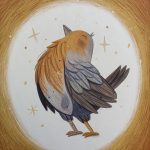A while back I asked the question, How much bird is there, anyway? which was a comparative look at apparent, visible, often in your face biomass we observe when we as diurnal primates look around us. I had noted that if you took a quick look around you’d think there were a lot of birds and very few mammals. Of course, a lot of the mammals would be hiding. And some of them would be hiding behind bushes waiting for a chance to jump on some of the birds. Which brings us to the present post, in which we ask “How many birds are there?”
Statue “Phillis Wheatley” by Meredith Bergmann, in Boston. Makes you think. Photo by Clairity.
I have no new information or insights to offer you here; as far as I know this issue has been addressed in a number of places including this very interesting if not very current blog post by John Trapp. In short, the answer is that in the United States there are 20 billion birds at the end of the breeding and fledging season, which gets winnowed down to 10 billion by the following early spring. For the present, we’ll keep the conversation in the United States; variation from region to region in bird die off may be great and meaningfully complex.
Things are obviously very complicated when looking at this question, and the nature of the count needs to be considered in relation to the question being asked. For instance, assume (and I will NOT stand by this number, it is just one I’ve heard here and there) that kitty cats in America kill 50,000,000 birds a year. If so, then that means that of the 10,000,000,000 birds that apparently die each year, kitties are responsible for perhaps 5%. But really, they may be responsible for a much much larger percentage of certain kinds of birds, with much of the death by kitty being confined to song birds and the like. Hardly any Sandhill Cranes are killed by domestic (including ferrel domestic) cats. Raptors either. In fact, there are certainly a few cats killed by hawks every year.
So, 5% of all birds might mean 10% of all song birds and really, it might be 20% or more of all the birds that die in a given year for specific species, with the species involved being those that are common to a specific habitat in which the cats are found. Is this a problem? I’m also not going to take a position on that but I have a few thoughts.
1) The total percentage of a species that is killed by some force may have a very large evolutionary or adaptive effect even if the percentage is very small, like in the 0.5 to 2% range, if the individuals killed are almost always the same as each other in having some trait that makes them more likely to be killed.
2) In contrast, even a very large percentage may have very little evolutionary or adaptive effect if those killed are randomly selected from the population.
3) Some of these birds were going to die anyway. I mean, seriously, half of the total number of birds found during the annual peak die. Of those, some were going to die of hyperthermia or other energetic issues, in other words, lack of food and not enough thermoregulation during a few cold nights, or some other environmental effect, which kills a lot of birds.
4) Others were going to die anyway by being killed by a whatever predator the cats have displaced. But this is problematic. Kitty cats are not native to the region of concern here, and I’m pretty sure there is not a wild equivalent. Other felids are all much larger, the similar sized carnivores are things like minks and ferrets, and they have very different habits. If cats displace ferrets, then that probably means that birds are getting hit harder than rodents, and among birds, adult birds are getting hit harder than eggs or hatchlings. We know from a lot of other case studies that switching around the carnivores in a region (i.e., adding wolves, who displace coyotes) can dramatically change the ecology and directly affect species diversity and abundance.
5) When it comes to predation, aren’t most birds killed by other birds? I’m just sayin’…
6) All of this, or at least most of this, is being played out against the backdrop of a potentially much larger set of changes. These cats come along with farms. Farms are enormous in their effects on birds. The cats come along with suburbs. So for every cat there is X kilos of bird food, Y acres of woodland turned to lawn, Z percentage of native trees replaced with mulberries (yay) and buckthorn (boo) which have highly variable effects on forage and nesting sites, and so on. The cats come along with cities. Let’s talk about cities for a second.
I used to be a very active archaeologist. I did archaeology for 20 hours a day seven days a week 365 days a year for a couple/few decades. One of the projects I did was related to the famous Big Dig in Boston, the largest public works project ever carried out by human beings. One of the things that project involved was removing about ten miles of overhead highway and putting that underground. Every mile of highway had lanes bound in two directions, and each “lane” had multiple traffic lanes held up by steel structures. So, for each mile of highway there were about ten I-beams. Each I-beam had two sides. So, about 200 miles of ledge was to be removed from the city scape and replaced with nothing. What lived on those ledges? Starlings. About 100% of the ledge space was filled with starling nests. Let’s conservatively estimate that each nest took up about a foot of space, which gives us about one million nesting pairs of starlings, or, 2 million starlings and their offspring. These birds mostly left the city to feed on farms out in Concord and Lexington and other distant suburbs of Boston. Many foraged in the city as well (and yes, maybe about 5% of the ledge was used by other species).
Based on the numbers given earlier, I’d estimate the total number of birds in the greater Boston area as being less than five million. If you lived in the region, you would not be at all shocked to hear me suggest that more than 20% of those birds are starlings. They are really, really common there. Or, at least, they were when I lived there before the highway was sunk. Knocking out the nesting area for a huge percentage of the starlings (an invasive species, as you know) in a large are would have a huge impact on all the other birds, probably a very positive one. But, of course, these starling were feeding for much of the year on farm fields, which are not the natural habitat of that region (it should be woodland, wetland, marshland, and shoreline). Given all this, the cats can’t really matter that much, can they?
Well yes! Remember point #1 above. It depends.
Which brings us to windmills and building strikes. Which we shall discuss another time.













Hello – I enjoyed reading your well written post. I’ve always followed this topic with interest. I’ve often wondered why cat people always seem to fail to see the problem with letting their pets run free. And the issue as to why cats are not subject to the same regulation as dogs, ponies, chickens, whatever. Nothing irritates me more than seeing fresh cat tracks going the length of my freshly washed car, then stepping in the fresh pile of poo in my yard. All I’m saying is, keep YOUR pet in YOUR yard. No matter what the species of pet is.
What is a good response to people whose standard reply is it is a cats nature to roam? And if you try to give numbers to the damage caused by sweet little “Whiskers”, they come back saying those are just inflated numbers from some anti-cat group. I’ve had this discussion with a lady at work many times who feels it is her duty to feed every stray cat in town and usually has 10 to 12 strays wandering around outside her house. Followed by the inevitable kittens.
And I actually like cats. Just keep the dang thing in your yard!
Joe
Great post! I can easily understand that 10 billion birds die off each year and that billions of birds are in the U.S.
To Joe, your comment about cats is very true. I think you would appreiate this video of a a cat getting attact by a bird in its own yard. Pretty Funny! http://www.youtube.com/watch?v=TcrR1BDyMIY
It might well matter to native predators that kill songbirds as well as those animals that might eat them as carrion. The answer to the question is simple though. If you have a cat, the answer is yes; if you don’t have a cat, the answer is no. There are predators besides birds that eat songbirds, but most of that mortality probably occurs in the nest or just after fledging–have you ever seen a chipmunk or squirrel work the shrubbery to find nests? They are very efficient. Snakes are also effective predators of eggs and nestlings. I have seen weasels go after fledglings, but I don’t think mink would have a noticeable impact(ferrets? there is only one ferret species native to the US and it is highly endangered). Then we have feral Rattus norvegicus, which are quite agile predators of both mice and birds. Of course, corvids are notorious predators of eggs and nestlings. Considering the declines seen in common bird populations in the US, my answer is no, there aren’t enough birds that cats don’t matter, because the effects go beyond just birds.
About cats, back in the 1960s in graduate school I heard a presentation by an ecologist. He had studied cat predation on small rodents in a California grass land. He found that feral house cats would hunt one prey species to extiction before switching on another. We were all puzzled by this because it did not fit the prudent predator paradigm. Years later I realized he was talking about the impact of an exotic predater on an ecosystem, not the effect of a coevolved predator.
That is actually common cat behavior. Not to extinction, but focusing on one species until the numbers go so low that they switch to another. For most wild cats, other perturbations in the system result in that never happening, but it can happen.